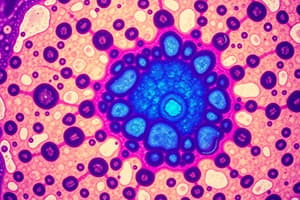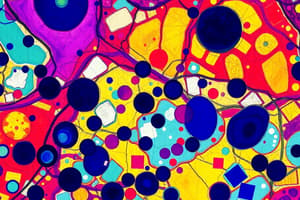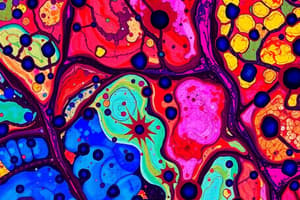Podcast
Questions and Answers
What color does Best's carmine stain glycogen?
What color does Best's carmine stain glycogen?
- Yellow
- Red (correct)
- Green
- Blue
Which of these substances can be stained with Sudan III?
Which of these substances can be stained with Sudan III?
- Carbohydrates
- Lipids (correct)
- Proteins
- Nucleic acids
What are cytoplasmic inclusions primarily composed of?
What are cytoplasmic inclusions primarily composed of?
- Membranous organelles
- Cytoplasmic matrix
- Stored substances (correct)
- Ribosomes
Which of the following is a membranous cell organelle?
Which of the following is a membranous cell organelle?
What is the primary function of the cell membrane?
What is the primary function of the cell membrane?
Which of the following is NOT a vital property of a cell?
Which of the following is NOT a vital property of a cell?
What is the primary aim of the histology course?
What is the primary aim of the histology course?
Which type of microscope has the highest optical resolution?
Which type of microscope has the highest optical resolution?
What type of solution is the cytoplasmic matrix?
What type of solution is the cytoplasmic matrix?
Which of these correctly describes the structure of the cell membrane seen under an electron microscope?
Which of these correctly describes the structure of the cell membrane seen under an electron microscope?
What is the maximum magnification power of a light microscope?
What is the maximum magnification power of a light microscope?
Which stain is used for staining basic structures?
Which stain is used for staining basic structures?
What is a supravital stain used for?
What is a supravital stain used for?
Which stain is known for staining reticular fibers?
Which stain is known for staining reticular fibers?
What type of structures do basic stains target?
What type of structures do basic stains target?
What occurs during metachromatic staining?
What occurs during metachromatic staining?
What is the primary function of mitochondria in the cell?
What is the primary function of mitochondria in the cell?
Which process occurs when solid substances enter the cell?
Which process occurs when solid substances enter the cell?
What structures are formed during bulk transport for macromolecules?
What structures are formed during bulk transport for macromolecules?
Which of the following is NOT a component of mitochondria?
Which of the following is NOT a component of mitochondria?
What is the primary site of energy production in the mitochondria?
What is the primary site of energy production in the mitochondria?
What type of transport process occurs when substances leave the cell?
What type of transport process occurs when substances leave the cell?
Which organelles are responsible for producing their own proteins?
Which organelles are responsible for producing their own proteins?
Which process refers to the uptake of liquid by the cell?
Which process refers to the uptake of liquid by the cell?
What characterizes euchromatin?
What characterizes euchromatin?
What is the primary function of the nucleolus?
What is the primary function of the nucleolus?
What type of chromatin is typically associated with inactive genes?
What type of chromatin is typically associated with inactive genes?
Which of the following descriptions is true about nuclear sap?
Which of the following descriptions is true about nuclear sap?
Where is peripheral chromatin located?
Where is peripheral chromatin located?
What is the primary function of lysosomes?
What is the primary function of lysosomes?
What are primary lysosomes characterized by?
What are primary lysosomes characterized by?
Which type of lysosome is formed by the fusion of primary lysosomes with phagocytic vesicles?
Which type of lysosome is formed by the fusion of primary lysosomes with phagocytic vesicles?
What is the main characteristic of ribosomes?
What is the main characteristic of ribosomes?
Which of the following is NOT a function of lysosomes?
Which of the following is NOT a function of lysosomes?
What type of vesicle do secondary lysosomes contain after fusion with primary lysosomes?
What type of vesicle do secondary lysosomes contain after fusion with primary lysosomes?
What is one of the roles of lysosomes in the reproductive process?
What is one of the roles of lysosomes in the reproductive process?
Which organelles are described as 'the digestive system of the cell'?
Which organelles are described as 'the digestive system of the cell'?
Flashcards are hidden until you start studying
Study Notes
Histology
- The study of the microscopic structure of normal tissues
- Aims to correlate the structure of cells, tissues, and organs with their functions.
- Uses different types of microscopes, primarily Light Microscopes (LM) and Electron Microscopes (EM).
Microscopy
- Optical resolution refers to the minimum distance between two points for them to be perceived as separate.
- This distance is approximately 0.2 mm for the human eye, 0.2 μm for LM, and 0.2 nm for EM.
- Magnification power is much greater for EM (more than x100,000) than for LM (approximately x1000).
Staining Techniques
- Cells are generally colorless and difficult to distinguish under LM unless stained.
- Acidic stains (e.g., eosin) stain basic structures, making them acidophilic.
- Basic stains (e.g., hematoxylin) stain acidic structures, making them basophilic.
- Neutral stains (e.g., Leishman's stain) are a combination of acidic and basic stains used for staining blood cells.
- Vital stains can be used to stain living structures within a living animal (e.g., trypan blue or India ink for phagocytic cells).
- Supravital stains can stain living cells outside a living organism (e.g., brilliant cresyl blue for reticulocytes in blood films).
- Metachromatic stains cause a change in color after staining, different from the original color. This change occurs due to a chemical reaction between the stain and specific cell structures (e.g., toluidine blue staining granules within mast cells violet).
- Orcein stain stains elastic fibers brown.
- Silver stain stains reticular fibers brown or black and can also demonstrate Golgi apparatus in cells.
- Osmic acid stains myelin sheaths black.
- Histochemical and cytochemical stains localize and demonstrate specific substances within a tissue or cell based on biochemical reactions.
- Glycogen stains red with Best's carmine.
- Lipids (fat) stain black with Sudan black and orange with Sudan III.
- Enzymes can be stained using specialized methods (e.g., alkaline phosphatase enzymes).
The Cell – The Unit of Life
- The basic functional and structural unit of all living tissues.
- Possesses vital properties such as growth, secretion, excretion, digestion, and reproduction.
- Cells vary in shape, size, and function but share a similar composition.
- All cells, except red blood cells (RBCs) and platelets, consist of cytoplasm and a nucleus.
Cytoplasm
- Contains:
- Cytoplasmic matrix: A colloidal solution of proteins, carbohydrates, lipids, minerals, and enzymes.
- Cytoplasmic organelles: Permanent, minute living structures essential for cell processes (e.g., respiration, secretion, digestion).
- Cytoplasmic inclusions: Non-living, temporary structures that are stored substances within some cells (e.g., glycogen, fat, pigments).
Cytoplasmic Organelles
- Classified based on the presence or absence of membranes:
- Membranous cell organelles:
- Cell membrane
- Mitochondria
- Endoplasmic reticulum (Rough & Smooth)
- Golgi apparatus
- Lysosomes
- Non-membranous cell organelles:
- Ribosomes
- Cytoskeleton
- Microtubules
- Filaments (Thin, Intermediate, Thick)
- Membranous cell organelles:
Membranous Cell Organelles
1-Cell Membrane
- Surrounds the cell, forming an envelope or cover.
- Invisible under LM due to its thinness (8-10 nm). Can be stained with silver (Ag) or periodic acid-Schiff (PAS).
- Appears as three parallel lines under EM: two dark layers separated by a light layer, forming a trilamellar membrane.
- The cell membrane has an outer coating rich in carbohydrates called the cell coat.
- Molecular structure: composed of lipids, proteins, and carbohydrates.
2- Mitochondria
- A membranous cell organelle responsible for cell respiration and energy production ("powerhouse of the cell").
- Number varies depending on cell activity (e.g., 1000-2000 in liver cells). Absent in RBCs.
- Located at sites of high activity (e.g., apical in ciliated cells).
- Appear as granules, rods, or filaments under LM, requiring special stains for visualization (e.g., iron hematoxylin for black staining, Janus green for green staining).
- Under EM:
- Each mitochondrion appears as a rounded or oval vesicle.
- Covered by double membranes separated by a narrow intermembranous space.
- Outer membrane is smooth.
- Inner membrane forms incomplete folds called cristae.
Functions:
- Production of energy (ATP) through oxidative enzymes.
- Capable of forming their own proteins and division due to the presence of DNA and RNA.
3- Endoplasmic Reticulum (E.R)
- A membranous organelle made of flattened interconnected tubules that form a network within the cytoplasm.
- Classified into:
- Rough E.R (RER):
- Contains ribosomes on its surface.
- Involved in protein synthesis, folding, and transport.
- Smooth E.R (SER):
- Lacks ribosomes.
- Involved in lipid synthesis, detoxification, and calcium storage.
- Rough E.R (RER):
Golgi Apparatus
- A membranous organelle consisting of stacks of flattened sacs (cisternae).
- Functions:
- Concentration and modification of proteins synthesized by RER.
- Packaging and secretion of proteins in secretory vesicles.
- Isolation and packaging of hydrolytic enzymes in lysosomes.
- Formation and maintenance of cell membranes and cell coats.
5- Lysosomes
- Membranous organelles enriched in hydrolytic enzymes, considered the "digestive system" of the cell.
- Numerous in phagocytic cells (e.g., white blood cells).
- Demonicated with special stains for their enzymes under LM (e.g., acid phosphatase enzyme).
- Under EM:
- Primary lysosomes: Newly formed, small, rounded, homogenous vesicles.
- Secondary lysosomes: Result from the fusion of primary lysosomes with intracellular macromolecules. Appear heterogeneous.
- Types of secondary lysosomes:
- Heterolysosomes: Primary lysosomes + phagocytic vesicle (food or bacteria).
- Multivesicular bodies: Primary lysosomes + pinocytic vesicle (fluid droplets).
- Autolysosomes: Primary lysosomes + vacuoles (old organelles).
- Residual bodies: Secondary lysosomes containing undigested remnants, secreted outside the cell or accumulated as lipofuscin granules in long-lived cells (e.g., cardiac muscle or nerve cells).
- Functions:
- Digestion of nutrients within the cell.
- Defense against bacteria and viruses.
- Removal of damaged or old organelles.
- Lysis of cells and the body after death.
- Conversion of inactive hormones to active forms (e.g., in thyroid gland).
- Assists sperm penetration of the ovum.
Non-membranous Cell Organelles
1- Ribosomes
- Non-membranous cell organelles formed within the nucleolus.
- Composition: Ribonucleoprotein (rRNA + protein).
- Very small (15-20 nm), difficult to visualize under LM.
- Appear as basophilic structures when stained with hematoxylin.
- Two types:
- Free ribosomes: Found dispersed in the cytoplasm, responsible for synthesizing proteins for use within the cell.
- Bound ribosomes: Attached to RER, synthesize proteins to be secreted or incorporated into cellular membranes.
2- Cytoskeleton
- A network of protein filaments that provides support, structure, and motility to the cell.
- Components:
- Microtubules: Hollow tubes composed of tubulin, involved in cell shape, organelle movement, and cilia/flagella formation.
- Filaments:
- Thin filaments (actin filaments): Involved in cell movement, muscle contraction, and cytokinesis.
- Intermediate filaments: Provide structural support and anchor organelles.
- Thick filaments (myosin filaments): Involved in muscle contraction.
The Nucleus
- The control center of the cell.
- Contains genetic material (DNA) organized into chromosomes.
- Responsible for directing cell activities and replication.
- Structure under LM:
- Nuclear membrane: Double-layered membrane surrounding the nucleus.
- Chromatin: Material composed of DNA and associated proteins.
- Euchromatin: Extended form of chromatin, appears pale, contains active genes, present in active cells.
- Heterochromatin: Condensed form of chromatin, appears dark, contains inactive genes, present in inactive cells.
- Nucleolus: Dark, basophilic structure within the nucleus, responsible for rRNA synthesis and ribosome assembly.
- Nuclear sap: Fluid filling areas between the nucleolus and chromatin islands, acts as a transport medium.
Functions:
- Directs cell division: Contains chromosomes carrying genetic information.
- Controls vital cell processes: Directs protein synthesis, metabolism, and other cellular functions.
- Forms different types of RNA (mRNA, tRNA, rRNA): Essential for protein synthesis and other cellular processes.
Studying That Suits You
Use AI to generate personalized quizzes and flashcards to suit your learning preferences.




